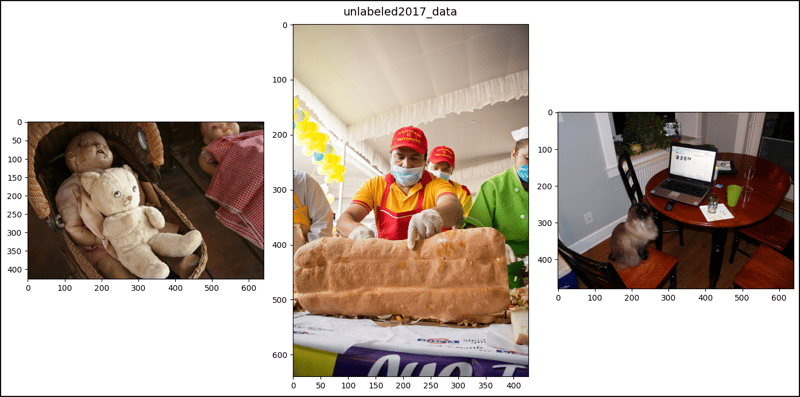CocoCaptions in PyTorch (3)
This post demonstrates using the CocoCaptions class from the torchvision.datasets library with various MS COCO datasets. The examples illustrate loading and displaying images from the unlabeled2017 subset. However, attempts to access data from stuff_train2017, stuff_val2017, stuff_train2017_pixelmaps, and stuff_val2017_pixelmaps resulted in errors, indicating incompatibility with CocoCaptions. The code snippets and their outputs are provided below.
Code and Output:
The code attempts to load and utilize different subsets of the MS COCO dataset using CocoCaptions. The unlabeled2017 subset loads successfully and allows for image display. Other subsets (containing "stuff" and "panoptic" data) cause errors, highlighting limitations of using CocoCaptions with these specific data structures.
from torchvision.datasets import CocoCaptions
import matplotlib.pyplot as plt
# ... (CocoCaptions instantiation code as provided in the input) ...
# ... (len() calls and error handling code as provided in the input) ...
unlabeled2017_data[2] # Displays image and empty caption list
unlabeled2017_data[47] # Displays image and empty caption list
unlabeled2017_data[64] # Displays image and empty caption list
def show_images(data, ims, main_title=None):
file = data.root.split('/')[-1]
fig, axes = plt.subplots(nrows=1, ncols=3, figsize=(14, 8))
fig.suptitle(t=main_title, y=0.9, fontsize=14)
for i, axis in zip(ims, axes.ravel()):
if not data[i][1]:
im, _ = data[i]
axis.imshow(X=im)
fig.tight_layout()
plt.show()
ims = (2, 47, 64)
show_images(data=unlabeled2017_data, ims=ims, main_title="unlabeled2017_data")The show_images function displays three images from the unlabeled2017_data subset.

Conclusion:
This experiment shows that while CocoCaptions works with certain MS COCO data subsets (like unlabeled2017), it's not directly compatible with all annotations. The errors encountered suggest that the "stuff" and "panoptic" annotations require a different approach or a different dataset class for proper loading and usage. Further investigation into the structure of these annotations and the available torchvision dataset classes is necessary for successful data access.
The above is the detailed content of CocoCaptions in PyTorch (3). For more information, please follow other related articles on the PHP Chinese website!

Hot AI Tools

Undresser.AI Undress
AI-powered app for creating realistic nude photos

AI Clothes Remover
Online AI tool for removing clothes from photos.

Undress AI Tool
Undress images for free

Clothoff.io
AI clothes remover

Video Face Swap
Swap faces in any video effortlessly with our completely free AI face swap tool!

Hot Article

Hot Tools

Notepad++7.3.1
Easy-to-use and free code editor

SublimeText3 Chinese version
Chinese version, very easy to use

Zend Studio 13.0.1
Powerful PHP integrated development environment

Dreamweaver CS6
Visual web development tools

SublimeText3 Mac version
God-level code editing software (SublimeText3)

Hot Topics
 How to solve the permissions problem encountered when viewing Python version in Linux terminal?
Apr 01, 2025 pm 05:09 PM
How to solve the permissions problem encountered when viewing Python version in Linux terminal?
Apr 01, 2025 pm 05:09 PM
Solution to permission issues when viewing Python version in Linux terminal When you try to view Python version in Linux terminal, enter python...
 How to avoid being detected by the browser when using Fiddler Everywhere for man-in-the-middle reading?
Apr 02, 2025 am 07:15 AM
How to avoid being detected by the browser when using Fiddler Everywhere for man-in-the-middle reading?
Apr 02, 2025 am 07:15 AM
How to avoid being detected when using FiddlerEverywhere for man-in-the-middle readings When you use FiddlerEverywhere...
 How to efficiently copy the entire column of one DataFrame into another DataFrame with different structures in Python?
Apr 01, 2025 pm 11:15 PM
How to efficiently copy the entire column of one DataFrame into another DataFrame with different structures in Python?
Apr 01, 2025 pm 11:15 PM
When using Python's pandas library, how to copy whole columns between two DataFrames with different structures is a common problem. Suppose we have two Dats...
 How does Uvicorn continuously listen for HTTP requests without serving_forever()?
Apr 01, 2025 pm 10:51 PM
How does Uvicorn continuously listen for HTTP requests without serving_forever()?
Apr 01, 2025 pm 10:51 PM
How does Uvicorn continuously listen for HTTP requests? Uvicorn is a lightweight web server based on ASGI. One of its core functions is to listen for HTTP requests and proceed...
 How to handle comma-separated list query parameters in FastAPI?
Apr 02, 2025 am 06:51 AM
How to handle comma-separated list query parameters in FastAPI?
Apr 02, 2025 am 06:51 AM
Fastapi ...
 How to solve permission issues when using python --version command in Linux terminal?
Apr 02, 2025 am 06:36 AM
How to solve permission issues when using python --version command in Linux terminal?
Apr 02, 2025 am 06:36 AM
Using python in Linux terminal...
 How to teach computer novice programming basics in project and problem-driven methods within 10 hours?
Apr 02, 2025 am 07:18 AM
How to teach computer novice programming basics in project and problem-driven methods within 10 hours?
Apr 02, 2025 am 07:18 AM
How to teach computer novice programming basics within 10 hours? If you only have 10 hours to teach computer novice some programming knowledge, what would you choose to teach...
 How to get news data bypassing Investing.com's anti-crawler mechanism?
Apr 02, 2025 am 07:03 AM
How to get news data bypassing Investing.com's anti-crawler mechanism?
Apr 02, 2025 am 07:03 AM
Understanding the anti-crawling strategy of Investing.com Many people often try to crawl news data from Investing.com (https://cn.investing.com/news/latest-news)...






